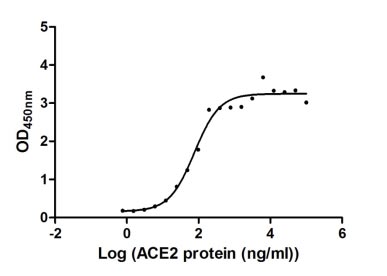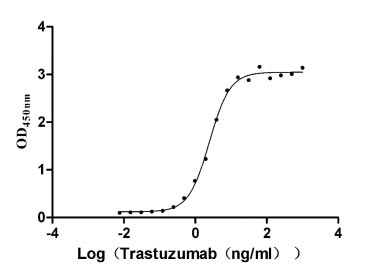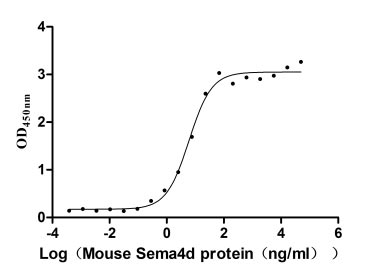Recombinant Rat Kappa-type opioid receptor (Oprk1)
-
货号:CSB-CF016359RA
-
规格:
-
来源:in vitro E.coli expression system
-
其他:
产品详情
-
基因名:
-
Uniprot No.:
-
别名:Oprk1; Ror-d; Kappa-type opioid receptor; K-OR-1; KOR-1
-
种属:Rattus norvegicus (Rat)
-
蛋白长度:Full length protein
-
表达区域:1-380
-
氨基酸序列MESPIQIFRGEPGPTCAPSACLLPNSSSWFPNWAESDSNGSVGSEDQQLEPAHISPAIPV IITAVYSVVFVVGLVGNSLVMFVIIRYTKMKTATNIYIFNLALADALVTTTMPFQSAVYL MNSWPFGDVLCKIVISIDYYNMFTSIFTLTMMSVDRYIAVCHPVKALDFRTPLKAKIINI CIWLLASSVGISAIVLGGTKVREDVDVIECSLQFPDDEYSWWDLFMKICVFVFAFVIPVL IIIVCYTLMILRLKSVRLLSGSREKDRNLRRITKLVLVVVAVFIICWTPIHIFILVEALG STSHSTAVLSSYYFCIALGYTNSSLNPVLYAFLDENFKRCFRDFCFPIKMRMERQSTNRV RNTVQDPASMRDVGGMNKPV
Note: The complete sequence including tag sequence, target protein sequence and linker sequence could be provided upon request. -
蛋白标签:N-terminal 10xHis-tagged
-
产品提供形式:Liquid or Lyophilized powder
Note: We will preferentially ship the format that we have in stock, however, if you have any special requirement for the format, please remark your requirement when placing the order, we will prepare according to your demand. -
缓冲液:Lyophilized from Tris/PBS-based buffer, 6% Trehalose, pH 8.0
-
储存条件:Store at -20°C/-80°C upon receipt, aliquoting is necessary for mutiple use. Avoid repeated freeze-thaw cycles.
-
保质期:The shelf life is related to many factors, storage state, buffer ingredients, storage temperature and the stability of the protein itself.
Generally, the shelf life of liquid form is 6 months at -20°C/-80°C. The shelf life of lyophilized form is 12 months at -20°C/-80°C. -
货期:Basically, we can dispatch the products out in 1-3 working days after receiving your orders. Delivery time may differ from different purchasing way or location, please kindly consult your local distributors for specific delivery time.Note: All of our proteins are default shipped with normal blue ice packs, if you request to ship with dry ice, please communicate with us in advance and extra fees will be charged.
-
注意事项:Repeated freezing and thawing is not recommended. Store working aliquots at 4°C for up to one week.
-
Datasheet & COA:Please contact us to get it.
相关产品
靶点详情
-
功能:G-protein coupled opioid receptor that functions as receptor for endogenous alpha-neoendorphins and dynorphins, but has low affinity for beta-endorphins. Also functions as receptor for various synthetic opioids and for the psychoactive diterpene salvinorin A. Ligand binding causes a conformation change that triggers signaling via guanine nucleotide-binding proteins (G proteins) and modulates the activity of down-stream effectors, such as adenylate cyclase. Signaling leads to the inhibition of adenylate cyclase activity. Inhibits neurotransmitter release by reducing calcium ion currents and increasing potassium ion conductance. Plays a role in the perception of pain. Plays a role in mediating reduced physical activity upon treatment with synthetic opioids. Plays a role in the regulation of salivation in response to synthetic opioids. May play a role in arousal and regulation of autonomic and neuroendocrine functions.
-
基因功能参考文献:
- Pre- and postsynaptic colocalization of kappa opioid receptor and D2R supports a role for kappa opioid receptor potentiating both the D2R inhibitory autoreceptor function and the inhibitory action of D2R on efferent medium spiny neurons. Kappa opioid receptor co-activation accelerates D2R sensitization by contributing to decrease dopamine release in the nucleus accumbens. PMID: 28531297
- Using selective agonists and antagonists showed that kappa-opioid receptor stimulation normalizes endothelial ultrastructure and function under hyperlipidemic condition. Its mechanism is related to the preservation of eNOS phosphorylation through activation of the PI3K/Akt signaling pathway and downregulation of iNOS expression/activity. PMID: 27226238
- These data suggest that kappa opioid receptors may have increased responsiveness following social isolation, which could lead to hypodopaminergia and contribute to an increased drive to consume ethanol. PMID: 26860203
- Hypertension increased the expression of Kappa Opioid receptors and heterodimerization of apelin receptors and Kappa Opioid receptors, and reduced pERK1/2 in the left ventricle. PMID: 28987634
- triazole 1.1 retained the antinociceptive and antipruritic efficacies of a conventional KOR agonist, yet it did not induce sedation or reductions in dopamine release in mice, nor did it produce dysphoria as determined by intracranial self-stimulation PMID: 27899527
- This is the first study to provide compelling evidence for a novel and unique neuromodulatory role for Kappa opioid receptors. PMID: 28163104
- Suggest that mixed cardiac ion channel blockade my mediated the antiarrhythmia actions of kappa-opioid receptor antagonist PD117,302. PMID: 26086860
- In conclusion, kappa-opioid receptors in the IL modulate pressor and tachycardiac responses caused by RS, suggesting a facilitatory role of this structure in this aversive situation. PMID: 25641629
- A brief stressor produces changes in the reward circuitry lasting several days. Our findings reveal roles for glucocorticoid receptors and kappaORs as mediators of the lasting effects of stress on synaptic plasticity. PMID: 24957331
- This study demonistrated that Oprk1 and Melanin-concentrating hormone colization in neuron in the lateral hypothalamus (LH) and zona incerta (ZI), but MCHR1 mRNA is widely expressed throughout the brain. PMID: 24978951
- These results, along with those reported previously, suggested that morphine dependence may be associated with regionally specific changes in kappa-opioid receptor expression in mesocorticolimbic system. PMID: 24219160
- kappa opioid receptor is reduced in stressed subjects, but does not contribute to age differences in ethanol-induced conditioned taste aversion. PMID: 23276674
- the present study demonstrates the importance of k-ORs in the attenuation of pulmonary artery hypertension during hypoxia. PMID: 23838631
- Negative affective states induced by alcohol withdrawal are induced in part by kappa-opioid receptors. PMID: 23212453
- Systemic activation of mu-receptors, but not delta- or kappa-receptors, is able to switch rapid- to shallow-breathing rats into a long-lasting apneic state. PMID: 22796630
- Kappa-opioid receptors influence the stretch-induced electrophysiological changes and play an antiarrhythmic role in cardiac arrhythmia following myocardial infarction. PMID: 22735633
- The kappa opioid receptor system is involved in regulating stress-related behaviors associated with ethanol. PMID: 22487769
- Activation of peripheral KORs directly blocks inflammatory hyperalgesia through stimulation of the nNOS/NO signaling pathway which is probably stimulated by PI3Kgamma/AKT signaling. PMID: 22316281
- data suggest that DOR-KOR heteromers exist in rat primary sensory neurons and that KOR antagonists can act as modulators of DOR agonist responses most likely through allosteric interactions between the protomers of the DOR-KOR heteromer PMID: 22072818
- Dysregulation of kappa-opioid receptor systems contributes to the excessive self-administration observed in alcohol dependent animals. PMID: 21338616
- The results of this study suggested that recovery from immobilization stress may alter striatal oprk1 mrna in male rats. PMID: 21723305
- findings suggest that fear conditioning and extinction dynamically regulate KOR expression in the BLA. PMID: 21531393
- Reduction of kappa-opioid receptor (KOR)/ mu-opioid receptor (MOR) by estrogen receptor blockade or spinal aromatase inhibition shifts spinal morphine antinociception from KOR dependent to KOR independent. PMID: 21849544
- provided evidence for mRNA transport and regulation of presynaptic protein synthesis of nonstructural proteins like KOR in primary sensory neurons [kappa-opioid receptor] PMID: 17167054
- The kappa-opioid receptor system does not function in an adult-like manner during the late preweanling period. A possible explanation is that the coupling between kappa-opioid receptors and their second messengers are not fully mature by PD 17. PMID: 20435099
- The nucleus accumbens and piriform cortex are identified as brain regions in which modifications in KOR function may differentiate the Wistar Kyoto strain from Sprague Dawley rats. PMID: 19924112
- phosphorylation of serine 369 mediates KOR desensitization and internalization PMID: 12815037
- Long-term effects on brain opioid receptor(kappa) after short periods of maternal separation in rats. PMID: 12842289
- Immunoblotting analysis of kappa-opioid receptors from butorphanol-withdrawal rats showed significant increases in 11 of 21 brain regions examined. PMID: 14580956
- both negative and positive functional interaction between delta, mu and kappa opioid receptors regulate the influence of MET on H(2)O(2) and NO production in rat peritoneal macrophages. PMID: 15467355
- Oprk1 is expressed in the cerebellar cortex. PMID: 15778854
- Our results point to an involvement of KOR and nNOS in the same intracellular network that controls the development of morphine tolerance and dependence. PMID: 15950775
- Regional changes in the mRNA for and protein levels of the kappa-opioid receptor focus attention on highly special roles for this receptor in the development of physical dependence on and the expression of withdrawal from butorphanol dependence. PMID: 16130146
- endogenous opioids modulate the pressor response to intracerebral AngII; this effect is mediated mainly through endogenous Oprk1 agonists rather than Oprm1; alteration of baroreceptor sensitivity by angII is modulated by endogenous kappa opioids. PMID: 17980907
- kappa-ORs afford cardioprotection primarily when activated prior to and not after reperfusion PMID: 18500486
- These data add to the growing literature showing that kappa opioid receptors can modulate diverse afferent signaling to the locus caeruleus. PMID: 19009591
- the antidipsogenic effect observed in rats following third ventricle injections of IL-1beta depend on the functional integrity of a brain kappa-opioid-dependent component. PMID: 19217659
- The present study has provided evidence for the first time of the precise location of kappa-ORs in PAs and PASMCs of rats and that hypoxia upregulates expression of kappa-ORs. PMID: 19462402
- the kappa-opioid receptor in the anteroventral preoptic region is important for the reduction of body temperature during hypoxia PMID: 19545549
- findings suggest that antinociception induced by activation of kappa opioid receptors in the TMJ region is mediated by the L-arginine/NO/cGMP pathway in both sexes PMID: 19567249
显示更多
收起更多
-
亚细胞定位:Cell membrane; Multi-pass membrane protein.
-
蛋白家族:G-protein coupled receptor 1 family
-
数据库链接:
KEGG: rno:29335
STRING: 10116.ENSRNOP00000010255
UniGene: Rn.89571
Most popular with customers
-
Recombinant Human Angiotensin-converting enzyme 2 (ACE2), partial (Active)
Express system: Mammalian cell
Species: Homo sapiens (Human)
-
Recombinant Human Receptor tyrosine-protein kinase erbB-2 (ERBB2), partial (Active)
Express system: Mammalian cell
Species: Homo sapiens (Human)
-
Recombinant Mouse Semaphorin-4D (Sema4d), partial (Active)
Express system: Mammalian cell
Species: Mus musculus (Mouse)
-
Recombinant Human Signal transducer CD24 (CD24)-Nanoparticle (Active)
Express system: Mammalian cell
Species: Homo sapiens (Human)
-
Recombinant Macaca mulatta Microtubule-associated protein tau (MAPT) (Active)
Express system: Mammalian cell
Species: Macaca mulatta (Rhesus macaque)
-
Recombinant Human Tissue factor pathway inhibitor (TFPI), partial (Active)
Express system: Mammalian cell
Species: Homo sapiens (Human)
-
Recombinant Human C-X-C chemokine receptor type 4 (CXCR4)-VLPs (Active)
Express system: Mammalian cell
Species: Homo sapiens (Human)
-
Recombinant Rat Intestinal-type alkaline phosphatase 1 (Alpi) (Active)
Express system: Mammalian cell
Species: Rattus norvegicus (Rat)








-AC1.jpg)











